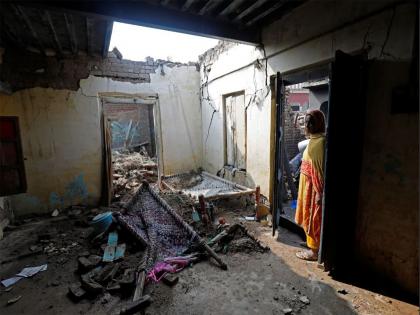Earthquake of magnitude 3.7 strikes Pakistan
By ANI | Updated: October 24, 2025 22:30 IST2025-10-24T22:27:55+5:302025-10-24T22:30:10+5:30
Islamabad [Pakistan], October 24 : An earthquake of magnitude 3.7 struck Pakistan on Friday, according to the National Centre ...

Earthquake of magnitude 3.7 strikes Pakistan
Islamabad [Pakistan], October 24 : An earthquake of magnitude 3.7 struck Pakistan on Friday, according to the National Centre for Seismology (NCS).
As per the NCS, the earthquake struck at a shallow depth of 10km, making it susceptible to aftershocks.
In a post on X, NCS said, "EQ of M: 3.7, On: 24/10/2025 10:14:26 IST, Lat: 36.64 N, Long: 72.77 E, Depth: 10 Km, Location: Pakistan."
{{{{twitter_post_id####}}}}EQ of M: 3.7, On: 24/10/2025 10:14:26 IST, Lat: 36.64 N, Long: 72.77 E, Depth: 10 Km, Location: Pakistan.
For more information Download the BhooKamp App https://t.co/5gCOtjdtw0 @DrJitendraSingh @OfficeOfDrJS @Ravi_MoES @Dr_Mishra1966 @ndmaindia pic.twitter.com/BvTjxawFfH
— National Center for Seismology (@NCS_Earthquake) October 24, 2025
Earlier on October 22, another earthquake struck the region.
In a post on X, NCS said, "EQ of M: 3.7, On: 22/10/2025 22:06:54 IST, Lat: 36.71 N, Long: 72.90 E, Depth: 10 Km, Location: Pakistan."
https://x.com/NCS_Earthquake/status/1981041049582874844
Shallow earthquakes are generally more dangerous than deep earthquakes. This is because the seismic waves from shallow earthquakes have a shorter distance to travel to the surface, resulting in stronger ground shaking and potentially more damage to structures, as well as greater casualties.
Afghanistan, Pakistan, and northern India lie in one of the most seismically active zones in the world, where the Indian and Eurasian tectonic plates meet. The region frequently experiences moderate to strong earthquakes, often felt across borders due to the proximity of fault lines.
Pakistan is among the seismically active countries in the world, crossed by several major faults.
This collision zone makes the country highly vulnerable to violent earthquakes. Provinces such as Balochistan, Khyber Pakhtunkhwa, and Gilgit-Baltistan lie on the southern edge of the Eurasian plate, while Sindh and Punjab are located on the northwestern edge of the Indian plate, contributing to frequent earthquake activity.
Balochistan is located near the active boundary between the Arabian and Eurasian tectonic plates.
Other vulnerable regions, such as Punjab, which lies on the northwestern edge of the Indian plate, are susceptible to seismic activity. Sindh, though less prone, is still at risk due to its location.
Disclaimer: This post has been auto-published from an agency feed without any modifications to the text and has not been reviewed by an editor
Open in app